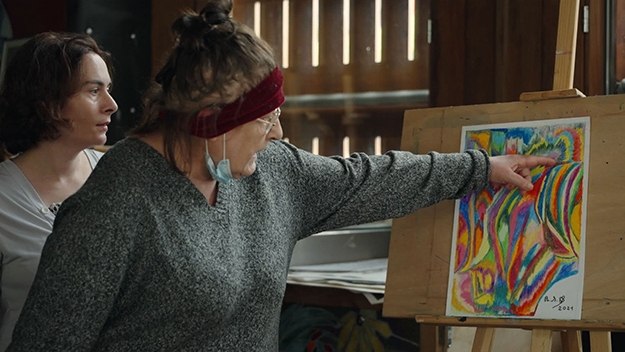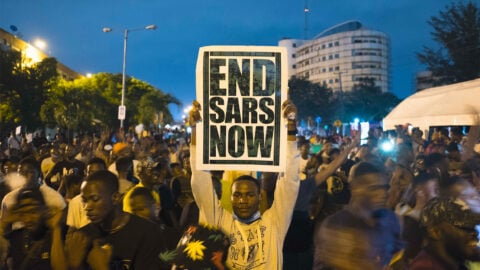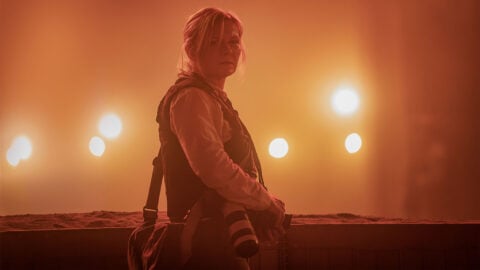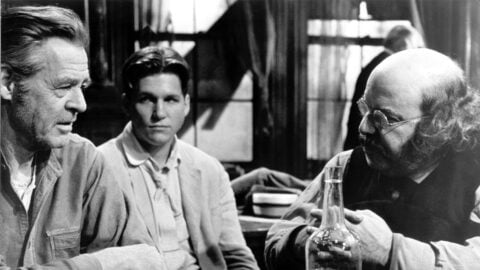Institutional Critique
This article appeared in the April 5, 2024 edition of The Film Comment Letter, our free weekly newsletter featuring original film criticism and writing. Sign up for the Letter here.

On the Adamant (Nicolas Philibert, 2023)
When Nicolas Philibert first saw Frederick Wiseman’s Titicut Follies, he was shocked. In a recent conversation between the two filmmakers in the French magazine Le Nouvel Obs, Philibert voiced the distress that so many have felt over the decades when watching Wiseman’s 1967 documentary about the treatment of mental patients at a Massachusetts hospital and correctional facility. What struck him was “the blindness of the guards, the social workers, and the doctors towards their own brutality. They treat the prisoners like objects and don’t see them, despite the camera.”
Philibert is stressing not just the staff’s casual inhumanity, but their obliviousness toward it, even while knowing themselves to be observed. Today, the French documentarist’s own studies of mental healthcare show not only how far this discipline has come since the ’60s, but also how the presence of a compassionate, observational camera can capture—and model—a collaborative relationship between care workers and patients. The first of a trilogy, Philibert’s On the Adamant—winner of the Golden Bear at the 2023 Berlinale—depicts a psychiatric outpatient center in Paris. The Adamant is situated on a boat moored on the Seine and was designed in consultation with staff and patients (or “passengers,” as Philibert likes to describe them). In the nonhierarchical environment of this drop-in service and social hub, “passengers” and staff together preside over meetings and hold roundtables and workshops. Relaxed sequences in the center’s café show the Adamant as a microcosm of a nation partly defined by café culture.
The film’s individual portraits show how diverse neurodiversity can be, with each of the subjects experiencing the world very differently. One young man explains how he uses jewelry to combat “negative vibrations,” while another talks us through his idiosyncratic associations, such as between a balaclava, the word “purée,” and the idea of death. Late-middle-aged François starts the film by singing “La Bombe humaine” (“Human Bomb”) by the French rock band Téléphone as a proud self-portrait, then bullishly expounds his views on the positive value of medication. The most striking portrait is of Frédéric, an elderly dandyish type who projects a languid, bohemian poet image, and whose complex personal mythology fuels his artistic expression. A highlight is his song inspired by Jim Morrison’s sojourn in Paris, its elegant Anglo-French wordplay matched by the oddly medieval-sounding melody of Frédéric’s organ accompaniment.
Frédéric epitomizes the creativity that is the basis of the Adamant’s approach: here the library is heavily stocked with poetry, and the film club shows Fellini and Kiarostami. Architecturally, too, the Adamant is its own metaphor for the possibilities of mental care: anchored but floating, protected but open to the world, its spacious interiors soaked in light from outside. An end caption reads, “In a world where thinking is so often reduced to box ticking, where embracing the singular is increasingly crushed, there are still places that resist, that attempt to maintain the poetic function of man and language.” The next caption ominously reads, “But for how long?” While facilities like the Adamant are part of France’s public healthcare system, Philibert is aware that mental health is particularly threatened by funding cuts. Bureaucrats, he has commented, tend to think along the lines of: “why bother trying to cure a schizophrenic when there’s no return on your investment?”
On the Adamant is part of Philibert’s long-term engagement with mental care, dating back to 1997’s Every Little Thing, about a rural clinic where patients rehearse an open-air drama. (On the Adamant was made in collaboration with psychologist Linda De Zitter, who also contributed to that film.) The second part of Philibert’s trilogy, At Averroès & Rosa Parks—which premiered at this year’s Berlinale—examines a more traditional institutional setting, showing consultations between doctors and patients at a hospital on the outskirts of Paris, some of them familiar as Adamant regulars. The third chapter, The Typewriter and Other Headaches, opens theatrically in France later this month, and depicts home visits to the protagonists of the earlier films.
The trilogy is part of a current cycle of French documentaries on healthcare that also includes Philibert’s Each and Every Moment (2018), about nurses in training. Discussing On the Adamant, Philibert (again in Le Nouvel Obs) stressed the importance of “patients speaking and carers listening, showing a different aspect of psychiatry that aims to be dignified, human.” Other films have underscored this listening prerogative in different contexts. Alice Diop’s On Call (2016) focuses on a medical center for refugees, where the consultations of individual patients illustrate the mental, cultural, and financial challenges experienced by socially marginalized migrants in France.
Emphasizing institutional structure and method, as opposed to Philibert’s portraiture of individuals, Claire Simon’s Our Body (2023) surveys a gynecological health department in a Paris hospital; again, attentive consultations form the central thread. Simon has persuaded her subjects to share their bodies with the camera, whether undergoing cesarean sections or receiving postmastectomy checkups; a departure from the film’s otherwise observational detachment arises from the fact that, in mid-production, Simon herself received a cancer diagnosis and started filming her own treatment. The director’s own appearances in the introduction and coda, as well as sequences showing her own medical appointments, democratize the film, making Simon less an outsider, more a participant expressing solidarity with other patients and (implicitly) with the hospital’s medical staff.
Our Body is especially vivid in depicting the interface of flesh and technology in meticulous, computer-guided surgical procedures. Such materiality is shown at its most intensely tangible in Lucien Castaing-Taylor and Véréna Paravel’s De humani corporis fabrica (2022). This documentary is as far as one can get from the Wiseman tradition of observational detachment—instead, it offers an immersive dive into the flesh, using miniaturized cameras to film procedures at very close range, plunging us deep into everything from eyeballs to scrotums. In a film as likely as any to induce fainting fits, the most unnerving act is listening—this time to the words of doctors, overheard in mid-operation, lamenting that their workload is taking them to the limits of exhaustion.
These films’ positive representations of professional skill and commitment can lead to suggestions of idealization: On the Adamant, for example, has been accused of downplaying the more painful aspects of mental illness. In fact, Philibert has always insisted on being rigorous about not presenting suffering as spectacle, and indeed about not just gaining his subjects’ consent to be filmed but also making sure that they appreciate the wider ramifications of giving such consent. Nevertheless, On the Adamant’s companion piece, At Averroès & Rosa Parks, shows some brutally intense cases of distress, while a critical inclusion in Simon’s film is footage from a demonstration protesting medical misogyny and violence.
And always implicit in these studies is a sense of how such institutions are hostage to the pressures of economics and conservatism; in the last few years of the Macron government, French medical workers have strongly protested budget cuts, while a severe shortage of general practitioners led France’s junior health minister to admit in 2022 that “about 87% of France could be called a medical desert.” On the Adamant shows a world very different from the harsh machineries of social control depicted in Wiseman’s early films like Hospital (1970), in which police presence is constant in the New York medical center’s wards and corridors. Yet Philibert’s sign-off in On the Adamant—“But for how long?”—reminds us how precarious a compassionate system might be, even in a nation where psychiatric day centers show Kiarostami films.
Jonathan Romney is a critic based in London. He writes for The Observer, Sight and Sound, Screen Daily, and other publications, and teaches at the U.K.’s National Film and Television School.







